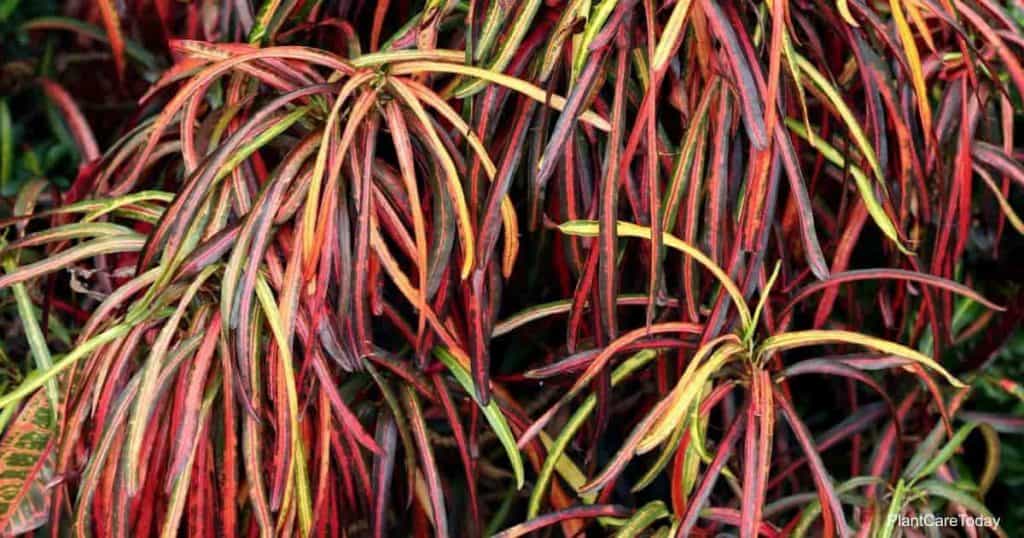Croton Zanzibar is a tropical plant native to the Western Pacific islands, Australia, Malaysia, and Indonesia.

It is a member of the Codiaeum variegatum family, pronounced [co-dee-ay’-um var-i-e-ga’-tum].
Most people just call it the Zanzibar croton. Croton is pronounced [kroh’-tn].
There are many croton varieties. Some have large, frilly leaves. Other varieties of Codiaeum variegatum have spiky, narrow leaves that are more reminiscent of swords or palms.
Zanzibar looks almost like grass. Its leaves are slender and long, but they are not just green.
They are usually spotted with shades of orange, purple, and red.
Zanzibar is an ideal plant for those who are looking for a contrast to the broad leaves of this plant’s siblings.
The Zanzibar croton is a perennial. It returns year after year. If it freezes and part of the plant dies, its root system should allow it to regrow. But, it might not survive cold temperatures in certain zones.
Other Popular Croton Varieties
Zanzibar Croton Plant Care
Size & Growth
The croton codiaeum Zanzibar is ideal to use as an indoor plant. It can also grow to the size of a shrub outdoors, developing up to 5′ feet tall and 3′ feet wide. It grows best in zones 9-11 with light shade and a moderate amount of water.
If grown plant indoor, it should reach a mature height of 2′ to 3′ feet tall. But, you will need to provide good bright light to achieve the dazzling colors these species produce.
This plant is easy to grow and makes an excellent addition to an indoor or outdoor garden.
Flowering and Fragrance
Crotons are not known for their flowers. But this plant family produces insignificant flowers. They are tiny and look more like berries.
Most gardeners enjoy Zanzibar for the colors of the leaves they produce. With leaves as ornamental as these, you don’t need the addition of blooms.
Light & Temperature
Because Zanzibar comes from a tropical climate, it prefers warm weather. That’s why it does best as a landscaping shrub in USDA hardiness zones 9 to 11.
At the same time, these plants do not flourish when they’re exposed to extreme heat. They do best in temperatures between 65° – 80° degrees Fahrenheit.
If you expose a Zanzibar croton to temperatures lower than 55° degrees Fahrenheit, their leaves may lose their intense coloring.
If you keep your Croton Zanzibar outdoors, bring it in when temperatures drop below 55° degrees Fahrenheit.
These could be indoor plants during the winter and a patio plant in the summer in cooler climates.
The hue of the leaves is dependent on the amount of light that these plants get. The partial sun helps them develop the best color.
The plants need some shade during the hottest times of the day.
When you keep Zanzibar croton indoors, make sure it has enough humidity. Place it near a bright window, and mist it regularly.
Or, place trays of water and pebbles near the plants. Outdoors, consider putting Zanzibar croton near a water feature.
Watering and Feeding
Do not keep the soil too wet. In the spring and summer, when the plant is in its growth stage, keep the soil moist.
You can tell when Zanzibar needs watering. Its new foliage will look droopy and wilted. Fertilize weekly with a liquid fertilizer during the growing season. Zanzibar does not need fertilizing during the winter.
More on Fertilizing Crotons here.
Soil & Transplanting
Plant Zanzibar in a rich but well-draining potting soil. Heavy soils hold water and lead to root rot. Slightly acidic soil is perfect for crotons. When grown outdoors, cover the dirt with organic mulch to keep the soil moist.
To transplant the Zanzibar
- Dig a hole slightly larger than the root ball.
- Place the plant in the hole
- Fill it with soil
- Water to settle the soil
You can follow these steps, whether you’re planting in a container or directly in the garden.
Grooming and Maintenance
Prune dead or overgrown leaves to keep your plant healthy and help it keep its shape.
If you’re pruning for aesthetic purposes, cut the leaf back to the previous node.
How To Propagate Croton?
Propagate Zanzibar from cuttings.
- Remove 3″ to 4″ inches of a branch with at least 3 leaves on it.
- Dip the end in a rooting hormone
- Stick the cutting in moist soil
- Keep the cuttings in a humid environment of about 80° degrees Fahrenheit.
- In about a month, the cuttings should have small roots.
- Transplant the small cuttings to a new pot
Air-layering is also another method of propagation.
Zanzibar Croton Pests Or Diseases
Croton Zanzibar plants are hardy and not very susceptible to pests or disease. But spider mites, mealy bugs, scale, and thrips can cause problems, especially indoors.
Inspect your plant regularly, looking for signs of infestation.